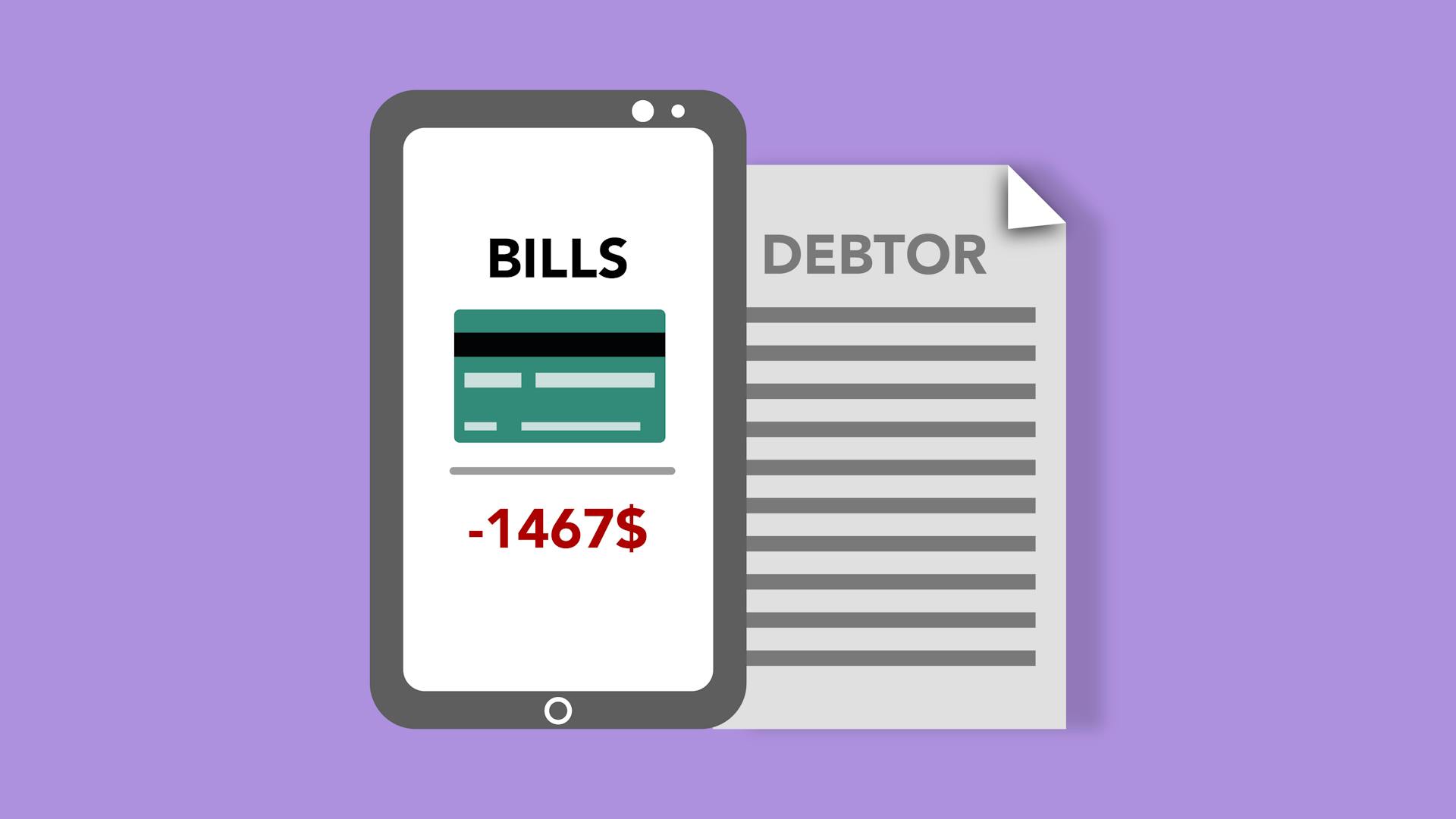
If you're struggling to make ends meet and are facing a financial crisis, you're not alone. Many people have found themselves in this situation, and there are options available to help.
Hardship programs for credit cards are designed to provide relief to individuals who are experiencing financial difficulties. These programs can temporarily suspend or reduce payments, interest rates, and fees.
Some credit card issuers offer hardship programs that can provide up to 90 days of relief from payments. This can give you some breathing room to get back on your feet.
To qualify for a hardship program, you'll typically need to provide documentation of your financial situation, such as proof of income loss, medical expenses, or other financial hardships.
Worth a look: How Do Debt Consolidation Companies Work
Applying for a Hardship Program
To apply for a hardship program, you'll need to contact your credit card issuer and ask about their hardship programs. Many major issuers, including Chase, Citibank, Bank of America, and American Express, offer these programs, but they may not advertise them publicly.
Worth a look: Discover Card Hardship

You'll need to be honest about your financial situation and explain why you're struggling to make payments. Be prepared to provide documentation to support your claim, such as a job termination letter, medical bills, or financial statements.
Some common examples of hardships that qualify for a hardship program include job loss, unemployment, serious illness, family emergency, divorce, and natural disasters. Service members may also be eligible for hardship programs under the Servicemembers' Civil Relief Act.
To enroll in a hardship program, you'll typically need to follow these steps:
- Document your hardship by gathering and submitting proof of your financial difficulties, such as a job termination letter or medical bills.
- Negotiate and agree to the terms of the program with your credit card issuer, including reduced interest rates, waived fees, or lower monthly payments.
- Complete the program according to the rules, making your new monthly payments on time and sticking to the agreed-upon terms.
It's essential to note that each credit card issuer may have different requirements and terms for their hardship programs, so be sure to ask about their specific program and what you can expect.
Some credit card issuers, like American Express, may offer more favorable terms, such as reduced interest rates or waived fees, to help you get back on your feet financially. However, it's crucial to carefully review the terms and conditions of any hardship program before enrolling.
Additional reading: What Is a Debt Consolidation Program
Impact on Credit and Finances

Enrolling in a hardship program can have several consequences for your credit and finances.
Your credit card issuer may reduce your credit limit, put a freeze on your card, or even close your account altogether. This can negatively impact your credit utilization rate and length of credit history, potentially affecting your credit score.
A credit card hardship program can also result in a negative strike against your credit score, making it harder to rebuild your credit over time.
Here are some potential effects on your credit score:
- Lowering the available credit limit on your account can increase your credit utilization rate, negatively impacting your credit score.
- Closing an older account can affect your length of credit history, potentially negatively impacting your credit score.
It's essential to consider these potential consequences before entering a hardship program, as they can have long-term effects on your financial situation.
Effect on Score
Enrolling in a hardship program can result in a negative strike against your credit score.
This is because a creditor may lower your available credit limit, increasing your credit utilization rate and potentially negatively impacting your credit score.
Closing an older account, especially one that's been in good standing, can also affect your credit score by shortening your length of credit history.
A single negative strike can take some time to rebuild, so it's essential to weigh the benefits of a hardship program against the potential risks to your credit score.
For your interest: Section 184 Indian Housing Loan Guarantee Program
Accounts May Be Impacted

Entering a hardship program may seem like a relief, but it can impact your accounts in unexpected ways. Your creditor may reduce your credit limit, put a freeze on your card, or even close your account altogether.
Before signing up, it's essential to know upfront all the associated details and potential impact on your account. Some creditors may be more lenient than others, but it's crucial to be aware of the possible consequences.
A reduced credit limit can increase your credit utilization rate, which can negatively impact your credit score. This is especially true if you're already struggling with debt.
Closing an older account can also affect your length of credit history, which can further damage your credit score. It's essential to weigh the benefits of a hardship program against the potential long-term effects on your credit.
Remember, it's always better to be informed and prepared before making a decision that can impact your financial situation.
Take a look at this: Do Home Equity Loans Hurt Your Credit
Alternatives to Hardship Programs

If your credit card issuer doesn't offer a hardship program, or if its terms don't work for you, consider some other avenues. Applying for a balance transfer credit card could potentially help you pay off your debt by transferring your existing card balances to a new credit card with a 0 percent introductory APR.
You could also look into hardship loans, which may offer lower interest rates for those who need money while recovering from financial hardship. Alternatively, a personal loan with a low interest rate and low fees could help.
Exploring debt consolidation loans is another option, which allows you to borrow a lump sum to pay off multiple existing debts. Consider finding a debt consolidation loan with a lower interest rate than your current loans to save money on interest charges.
Here are some alternatives to hardship programs to consider:
- Balance transfer credit card
- Hardship loans
- Personal loan
- Debt consolidation loan
- Credit counseling
- Debt settlement
- Bankruptcy (as a last resort)
Note: Credit counseling and debt settlement may have potential drawbacks, such as harming your credit score, so proceed with caution. Bankruptcy can significantly impact your credit score for seven to 10 years, depending on the type of bankruptcy.
If this caught your attention, see: Filing Bankruptcy on Credit Cards Only
Pros and Cons

A credit card hardship program may offer some benefits, but it's essential to consider the potential drawbacks. You may be allowed to pause or lower your payments, and your interest rate may be temporarily reduced.
Your credit score may not be severely damaged, and you could avoid default or bankruptcy. This can provide extra time to get back on your feet financially.
Here are some potential pros and cons to consider:
In some cases, a hardship program can help you save money on interest charges. For example, if you have a credit card with a high interest rate, entering into a hardship program may lower your interest rate, reducing the amount of interest you'll pay over time.
However, being in a credit card hardship program may temporarily negatively impact your credit scores. This can be a drawback, especially if you're already struggling with debt.
Additional reading: Does Fed Interest Rate Affect Credit Cards
Alternatives to
If your credit card issuer doesn't offer a hardship program, or if its terms don't work for you, consider some other avenues. You could ask the card issuer to lower your APR, which could help even if it's just a small drop.
A balance transfer credit card can be a good option, allowing you to transfer your high-interest balance to a new card with a 0% introductory APR. This can give you a temporary reprieve from interest, but be aware that you'll typically pay a fee of 3% or 5% of the transferred amount.
You could also explore debt consolidation loans, which allow you to borrow a lump sum to pay off multiple existing debts. This can help you save money on interest charges, but make sure to find a loan with a lower interest rate than your current loans.
Another option is to work with a credit counselor, who can provide financial education, resources, and debt management plans. Credit counselors can negotiate with creditors to reduce your debt and pay what you owe, but be cautious and research reputable, nonprofit credit counselors through the National Foundation for Credit Counseling.
If you're dealing with multiple accounts amounting to $10,000 or higher, debt settlement may be a more viable option. This can consolidate all of your current payment obligations into one affordable monthly payment, but be aware that it can potentially harm your credit score.
Here are some alternatives to hardship programs:
- Balance transfer credit card
- Debt consolidation loan
- Credit counseling
- Debt settlement
- Hardship loans
- Bankruptcy (as a last resort)
Note: These options may have pros and cons, and it's essential to understand the terms and conditions before making a decision.
Managing Your Finances

To manage your finances effectively, get a grasp on your new budget by building one based on your reduced income and expenses. This is crucial before contacting your card issuer.
The average APR for accounts that incurred interest in 2018 was 16.04%, so be sure to find your current APR on your credit card statement to determine what you can afford to pay in interest.
You can use your revamped budget to explain your financial circumstances to your lender as you negotiate a hardship program. This will help you make a stronger case for assistance.
Remember, knowing your current interest rate is a key number in your negotiation with the issuer.
Take a look at this: Current Expected Credit Losses
Understanding the Process
Credit card hardship programs can be a lifesaver during difficult financial times. They offer temporary relief from credit card debt, but it's essential to understand the process.
Not all credit card issuers offer hardship plans, and those that do may not advertise them. However, many did at the start of the COVID-19 pandemic.
Check this out: Account Not Appearing on Credit Report
To qualify for a hardship program, you typically need to provide documentation of your financial difficulties, such as pay stubs, medical bills, or divorce papers.
A hardship program may offer temporary measures to make your credit card debt payments more manageable, including due date extensions, lowered interest rate charges, pauses in payments and/or interest charges, reduced minimum payments, and waived late fees.
These modifications can lead to substantial savings, potentially amounting to thousands of dollars saved in interest and fees. However, credit card hardship programs don't last forever and often expire after three to 12 months.
Here are some key things to consider before agreeing to a financial hardship plan:
- What documentation is needed?
- When does the plan end?
- What are the ongoing requirements?
- Can you afford it?
- How will your credit card be affected?
- How will your account status be reported to credit reporting agencies during the plan?
Credit card companies generally work with hardship customers on a case-by-case basis, so don't be afraid to ask about alternatives if their first offer doesn't seem likely to help you.
Key Considerations
A credit card hardship program can be a lifesaver if you're struggling to make payments. Many credit card issuers offer these programs, even if they don't actively promote them.
If you're considering a hardship program, it's essential to weigh the pros and cons. Credit card hardship arrangements have benefits and potential drawbacks.
Here are some key considerations to keep in mind:
- A credit card hardship program may help you catch up without defaulting on your credit cards.
- Many credit card issuers offer credit card hardship programs to borrowers experiencing financial hardship.
- There are alternatives to credit card hardship programs, including balance transfer cards, debt consolidation loans, credit counseling, and debt settlement.
You should also know that credit card hardship programs can have some limitations. For example, you may need to make reduced payments for a set period or pay a fee to participate in the program.
Finding Relief
Credit card hardship programs can provide temporary relief by reducing or deferring your monthly payments, giving you some breathing room to get your finances back on track.
These programs are typically designed to last between 3-12 months, so it's essential to have a plan in place for long-term financial recovery.
If you're struggling to pay off your debt, consider seeking credit card debt relief. You might be a good candidate if your credit card debt is making it difficult to pay other bills, you're receiving collection notices, or you're feeling overwhelmed by your debt and overall financial situation.
Recommended read: Consumer Financial Protection Bureau Credit Cards
Here are some signs that you might need credit card debt relief:
- Your credit card debt is making it difficult to pay other bills.
- You’re receiving collection notices.
- You’re feeling overwhelmed by your debt and overall financial situation.
To find the right relief for you, consider talking to a nonprofit credit counselor. They can help you understand your options and develop a plan to manage your finances and pay off debt.
Sources
- https://www.experian.com/blogs/ask-experian/what-is-credit-card-hardship-program/
- https://americancreditcardsolutions.com/blog/understanding-credit-card-hardship-programs
- https://www.bankrate.com/credit-cards/advice/what-is-a-credit-card-hardship-program/
- https://www.creditkarma.com/credit-cards/i/credit-card-debt-relief
- https://www.nerdwallet.com/article/credit-cards/what-is-a-credit-card-hardship-program
Featured Images: pexels.com


